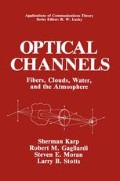Abstract
In Chapter 4 we examined the guided optical channel or fiber link. In this chapter we consider the turbulent atmosphere as an unguided optical channel. It is well known that turbulence-induced random fluctuations in the atmosphere’s temperature generate corresponding random irregularities in the index of refraction. Upon passing through these irregularities, the wavefronts associated with an optical beam become distorted, the magnitude of the distortions depending on the strength of the turbulence and the length of the atmospheric optical path. Among the effects which are attributable to wavefront distortion and which can seriously degrade the performance of an optical communication system are (1) spreading of the beam beyond that normally caused by diffraction, (2) scintillation of the received intensity, (3) a decrease in the spatial and temporal coherence, and (4) wander of the beam from position to position. Quantification of these effects requires a theoretical understanding of the relationship between the properties of the medium and the transmitted optical radiation.
Access this chapter
Tax calculation will be finalised at checkout
Purchases are for personal use only
Preview
Unable to display preview. Download preview PDF.
References
A. Ishimaru, Wave Propagation and Scattering in Random Media, Vols. 1 and 2, Academic Press, New York (1978).
V. I. Tatarski, Wave Propagation in a Turbulent Medium (translated by R. A. Silverman), McGraw-Hill, New York (1961).
V. I. Tatarski, The Effects of the Turbulent Atmosphere on Wave Propagation (translated by Israel Program for Scientific Translations), U.S. Department of Commerce, National Technical Information Service, Springfield, Virginia (1971) [originally published in 1967 ].
R. Fante, Electromagnetic beam propagation in turbulent media, Proc. IEEE 63, 1669–1692 (1975).
R. Fante, Electromagnetic beam propagation in turbulent media, an update, Proc. IEEE 68, 1424–1443 (1980).
S. F. Clifford, The classical theory of wave propagation in a turbulent medium, in: Laser Beam Propagation in the Atmosphere (J. W. Strobehn, ed. ), Springer-Verlag (1978).
D. Fried, Limiting resolution through the atmosphere, J. Opt. Soc. Am. 56, 1380 (1966).
R. E. Hufnagel and N. R. Stanley, Modulation transfer function associated with image transmission through turbulent media, J. Opt. Soc. Am. 54, 52–61 (1964).
R. E. Hufnagel and N. R. Stanley, Propagation through atmospheric turbulence, in: The Infrared Handbook (W. L. Wolf and G. J. Zissis, eds.), The Environmental Institute of Michigan, Ann Arbor, Michigan (1978).
D. Fried, Optical heterodyne detection of an atmospherically distorted wavefront, Proc. IEEE 55, 57–67 (1967).
R. Fante, Propagation of electromagnetic waves through a turbulent plasma using transport theory, IEEE Trans. Antennas Propagat. AP-2, 750–755 (1973).
R. Lutomirski and H. Yura, Propagation of a finite optical beam in an inhomogeneous medium, Appl. Opt. 10, 1652–1658 (1971).
Philip M. Morse and Herman Feshbach, Methods of Theoretical Physics, McGraw-Hill, New York (1953), pp. 804–806.
R. Fante, Mutual coherence function and frequency spectrum of a laser beam propagating through atmospheric turbulence, J. Opt. Soc. Am. 64, 592–598 (1974).
H. Yura, Mutual coherence function of a finite cross section optical beam propagating in a turbulent medium, Appl. Opt. 13, 1399–1406 (1972).
G. Parry, Measurement of atmospheric turbulence induced intensity fluctuations in a laser beam, Optical Acta 28, 715–728 (1981).
R. L. Phillips and L. C. Andrews, Measured statistics of laser-light scattering in atmospheric turbulence, J. Opt. Soc. Am. 71, 864–870 (1981).
E. Jakeman and P. N. Pusey, Significance of K-Distributions in Scattering Experiments, Phys. Rev. Lett., 40 (9), 546–550 (1978).
G. Parry and P. N. Pusey, K-distributions in atmospheric propagation of laser light, J. Opt. Soc. Am. 69 (5), 796–798 (1979).
E. Jakeman, On the statistics of K-distributed noise, J. Phys. A: Math. Gen. 13, 31–48 (1980).
R. Barakat, Weak-scatter generalization of the K-density function with application to laser scattering in atmospheric turbulence, J. Opt. Soc. Am. A 3, 401–409 (1986).
R. Barakat, Weak-scatter generalization of the K-density function. II. Probability density of total phase, J. Opt. Soc. Am. A 4 (7), 1213–1219 (1987).
E. Jakeman and R. J. A. Tough, Generalized K-distribution: a statistical model for weak scattering, J. Opt. Soc. Am. A 4 (9), 1764–1772 (1987).
D. Fried, Aperture averaging of scintillation, J. Opt. Soc. Am. 57 (1967).
Paul H. Deitz and Neal J. Wright, Saturation of scintillation magnitude in near-earth optical propagation, J. Opt. Soc. Am. 59 (5), 527–535 (1969).
H. Yura, Short term average optical-beam spread in a turbulent medium, J. Opt. Soc. Am. 63, 567–572 (1973).
D. Fried, Statistics of geometric representation of wavefront distortion, J. Opt. Soc. Am. 55, 1427 (1965).
H. Hodara, Refractive Index Fluctuations in Seawater, AGARD Lecture Series 61 on Optics of the Sea, Neuilly Sur Seine, France (1973), pp. 2.2–1–2.2.–12.
L. Lieberman, The effect of temperature inhomogeneities in the ocean on the propagation of sound, J. Opt. Soc. Am. 23, 563 (1951).
R. Fante, Intensity, Coherence and Frequency Spectrum of a Focused Beam in a Random Media, AFCRL Technical Report, AFCRL-TR-7 4–0335, Physical Sciences Research Papers No. 598 (1974).
R. D. Anderson and L. Stotts, Underwater measurements of off-axis radiance compared with various analytical treatments of the radiative transfer equation, J. Opt. Soc. Am. 72, 738–746 (1982).
M. Abramowitz and I. A. Stegun, Handbook of Mathematical Functions, Dover Publications, New York (1965), p. 505.
R. M. Gagliardi and S. Karp, Optical Communications, Wiley-Interscience, New York (1976).
Author information
Authors and Affiliations
Rights and permissions
Copyright information
© 1988 Springer Science+Business Media New York
About this chapter
Cite this chapter
Karp, S., Gagliardi, R.M., Moran, S.E., Stotts, L.B. (1988). The Turbulence Channel. In: Optical Channels. Applications of Communications Theory. Springer, Boston, MA. https://doi.org/10.1007/978-1-4899-0806-3_5
Download citation
DOI: https://doi.org/10.1007/978-1-4899-0806-3_5
Publisher Name: Springer, Boston, MA
Print ISBN: 978-1-4899-0808-7
Online ISBN: 978-1-4899-0806-3
eBook Packages: Springer Book Archive

